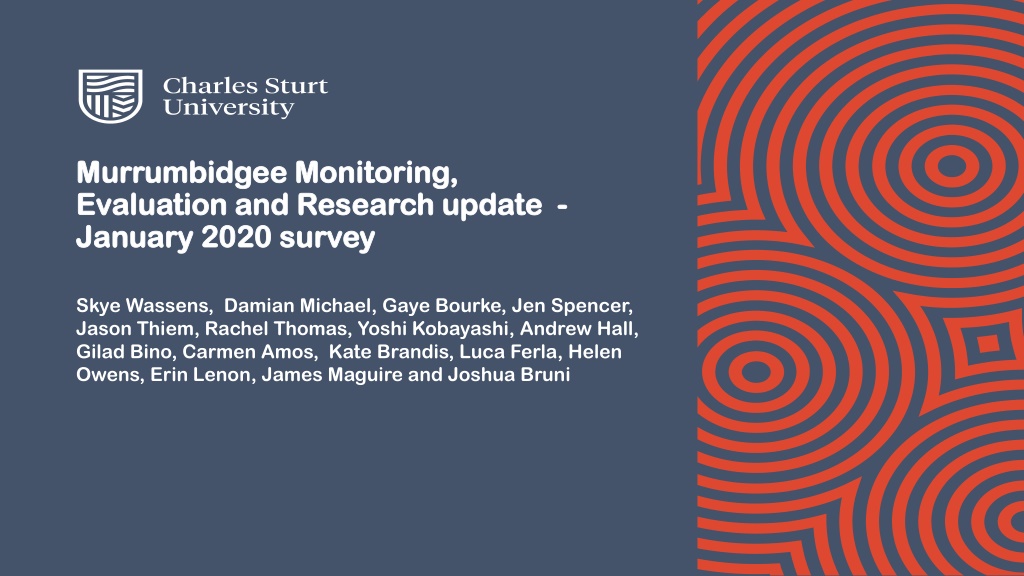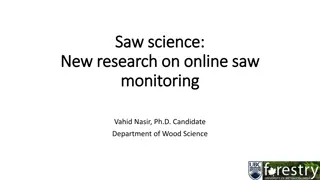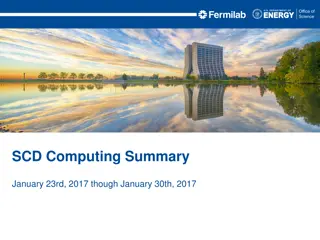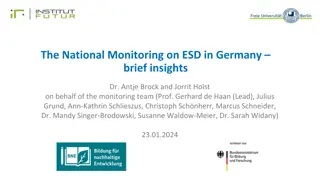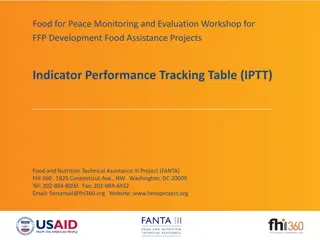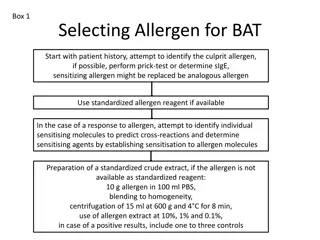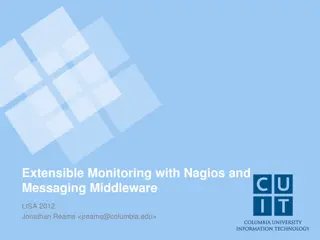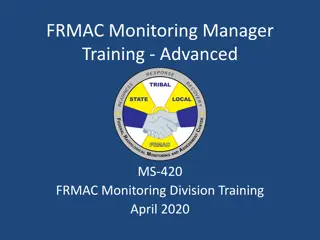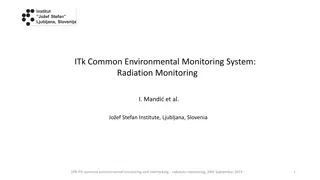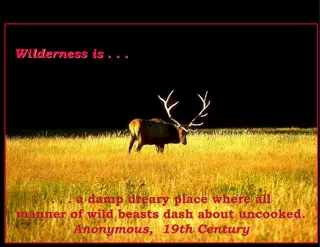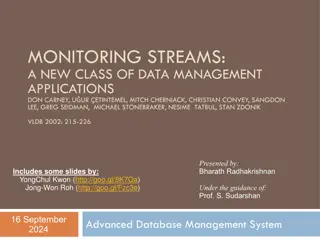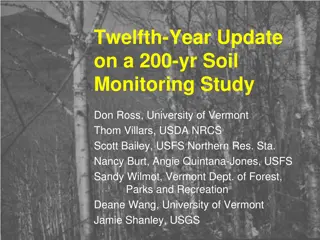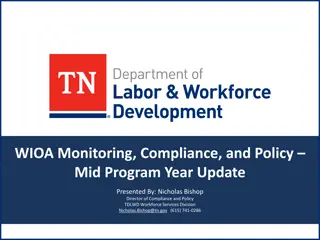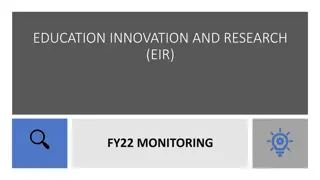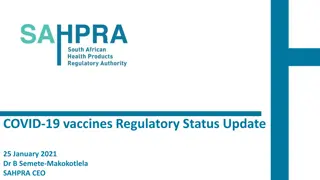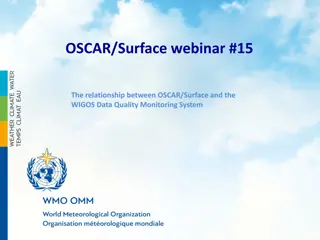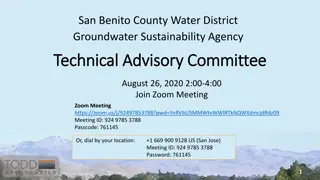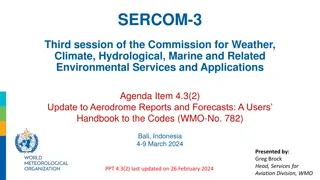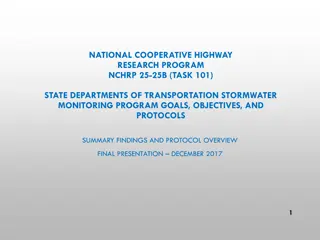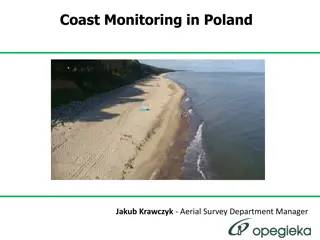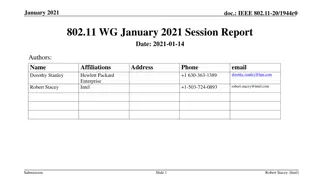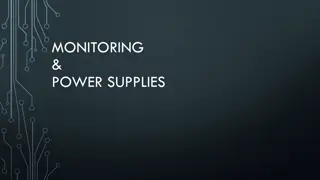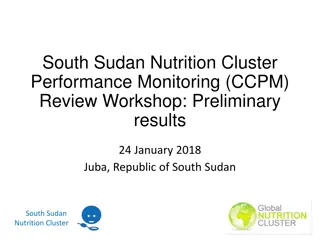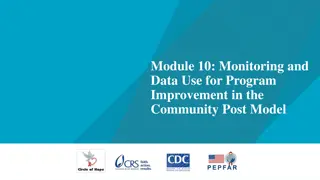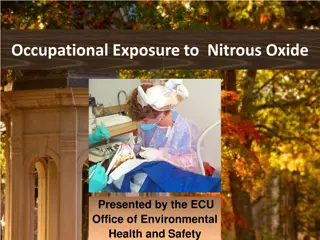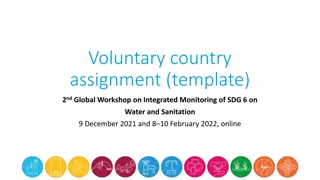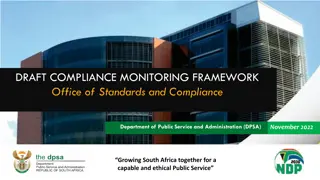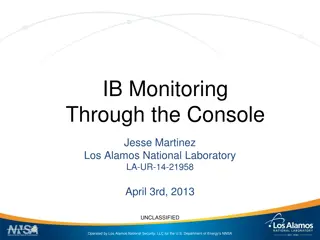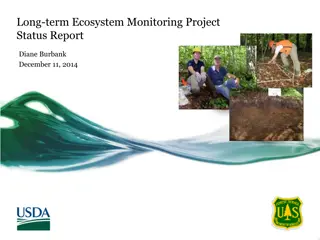Murrumbidgee Monitoring and Research Update - January 2020
Monitoring and evaluation of fish, frogs, tadpoles, water quality, and vegetation diversity were conducted at various sites in the Murrumbidgee region in January 2020. Wetland surveys indicated varied status at different sites, with detailed observations on environmental water levels. High numbers of fish were recorded, with native carp gudgeon dominating captures in certain locations. The report highlights site-specific findings and environmental conditions during the survey period.
Download Presentation

Please find below an Image/Link to download the presentation.
The content on the website is provided AS IS for your information and personal use only. It may not be sold, licensed, or shared on other websites without obtaining consent from the author. Download presentation by click this link. If you encounter any issues during the download, it is possible that the publisher has removed the file from their server.
E N D
Presentation Transcript
Murrumbidgee Monitoring, Murrumbidgee Monitoring, Evaluation and Evaluation and Research January 2020 survey January 2020 survey Research update update - - Skye Wassens, Damian Michael, Gaye Bourke, Jen Spencer, Jason Thiem, Rachel Thomas, Yoshi Kobayashi, Andrew Hall, Gilad Bino, Carmen Amos, Kate Brandis, Luca Ferla, Helen Owens, Erin Lenon, James Maguire and Joshua Bruni
Monitoring of fish, frogs, tadpoles, water quality and vegetation diversity was undertaken at 12 MER sites in January 2020. All sites were accessible, but two sites were either dry or held insufficient water to set nets. An additional pumped wetland (Mantangery Lagoon) and Monkem Creek were surveyed. Strong winds and dust storms occurred at Gayini Nimmie-Caira during the survey week. Conditions were hot and sunny in the mid-Murrumbidgee where daytime max temperatures reached 38-42C and overnight lows dropped to around 20C.
Wetlands surveyed during January Site Status Action Mantangery Lagoon Full - surveyed Environmental water complete Gooragool Lagoon Full - surveyed Environmental water complete Sunshower Lagoon Full - surveyed Environmental water complete McKennas Lagoon Dry - not surveyed Yarradda Lagoon full - surveyed Environmental water complete Nap Nap Drying down - surveyed Environmental water complete Avalon Swamp Full (dam) - surveyed Environmental water planned Eulimbah Swamp Full - surveyed Environmental water complete Mercedes (Pococks) Full - surveyed Environmental water complete Telephone Creek Full - surveyed Environmental water complete Two Bridges Drying down - surveyed Environmental water complete Piggery Lake Dry - not surveyed Environmental water planned Wagourah Creek Full - surveyed Environmental water complete Monkem Creek Full - opportunistic survey Environmental water complete
Wetland Fish (January 2020) Total numbers were high in comparison to spring (Sept/Nov) surveys Fish captures at Wagourah and Nap Nap were dominated by native carp gudgeon Native fish diversity highest at Yarradda Lagoon with carp/flathead gudgeon, smelt and bony bream. Two Bridges (Juveniles), Mantangery and Gooragool continue to support large numbers of common carp. No fish were detected in the recently water Sunshower Lagoon (low DO levels) 5
Wetland Frogs Call activity had predominantly finished across Lowbidgee and tadpole numbers were low compared to November counts. Observations were dominated by spotted marsh frog and barking marsh frog with low numbers of Peron s tree frog at most sites. Five frog species were detected at Sunshower in response to the pumping action (include first records of SBF in 10 years). Juvenile and adult southern bell frogs were recorded in very high numbers at Nap Nap, Eulimbah, and moderate numbers at Telephone Creek. 6
Southern bell frog relationship with environmental water Trends for the southern bell frog (presence/absence) in relation to water depth, survey month, wetland zone and water year between 2014-15 and 2018-19 in the Murrumbidgee Selected 8
Freshwater Turtles 25 Eastern Long-necked Turtles 2 Broad-shelled turtles Highest capture rates from Wagourah but Monkem Creek also supported a few ELT s Detection rate is comparable to previous surveys during warm months Mean carapace length = 21 cm (no juveniles)
Monitoring colonial waterbirds Systematic surveys of waterbird colonies were conducted in February 2020 and will continue in spring 2020. Complementary waterbird monitoring across the Murray-Darling Basin is also being undertaken by DPIE and UNSW, including ground-based or kayak surveys and annual aerial surveys completed by UNSW.
Key findings from February 2020 Most sites were drying down but good numbers of waterbirds at Suicide Swamp, Paika and Tala Lakes. Suicide - Freckled Duck, Blue-billed Duck, Wood Sandpipers and Australian Spotted Crake. Eulimbah - large numbers of juvenile White Ibis and Royal Spoonbill with a few nests with chicks and fledglings. Yarradda Lagoon supported 11 Darter nests and Gooragool supported 2 Darter and 2 Little Pied Cormorant nests. Photos: Australian White Ibis and female blue-billed duck Carmen Amos. Wood Sandpiper Damian Michael
Use of ABCS to monitor arboreal reptiles Four arboreal lizard species are found along the Murrumbidgee River but their distribution and abundance is poorly known. Artificial bark covers are being used by CSU Honours student Eva Moore to study their ecology and response to e-water. Aim 1: to evaluate the most effective survey method 1) ABC s, 2) spotlighting, or 3) active searches Aim 2: to explore tree colonisation and movement patterns in response to environmental watering actions (BACI design). Eva will mark lizards with VIE and track movements using fluorescent
Distribution and abundance of the Endangered Grey Snake Wetland dependant anaurophagous snake (End IUCN) 10 historical (1950 s) records from the lower Lachlan In Nov 2018, a population was discovered in the Lowbidgee (65) 32 observation, 4 individuals have been micro-chipped as part of a population and demographics study CSU Honours student Emma Stevens is investigating snake distribution and habitat use Aim: to explore relationships bw grey snake occupancy, environmental watering actions, frog diversity and vegetation structure. A priority species for EPBC nomination A range extension for the endangered Grey Snake Hemiaspis damelii (G nther 1876) in the Murrumbidgee catchment, southern NSW. Damian R. Michael, Gaye Bourke, Dena Paris and Skye Wassens Institute for Land, Water and Society, Charles Sturt University, Albury, 2640 NSW, Australia. *
Resource utilisation in Rakali Rakali is a top mammalian predator but less than 10 records exist from between Wagga and Balranald, although anecdotes indicate is it locally abundant. CSU Honours student, Emmalie Sanders will use a range of survey methods to help guide future monitoring programs. She will use camera traps, hair funnels and bait traps to compare detection rates below and above selected weirs (Redbank, Yanco, etc) matched with a semi-permanent wetland or creek.
Further information Twitter @BidgeeLTIM Instagram @BidgeeMER Flow-MER website Newsletter The Bidgee Bulletin Permits: NSW Scientific licence SL100441 DPIE Fisheries permit P11/0043-3.0 CSU Animal Ethics permit A19028
Acknowledgements We acknowledge the Wiradjuri, Nari Nari and Muthi Muthi peoples, traditional owners and custodians of the country on which we work. We also thank the following partner organisations for their involvement in and contribution to the MER program. Commonwealth Environmental Water Office (CEWO) Department of Planning, Industry and Environment (DPIE) University of New South Wales (UNSW) New South Wales National Parks and Wildlife Service (NSW NPWS) Department of Primary Industry (DPI) Riverina Local Land Services (RLLS)
